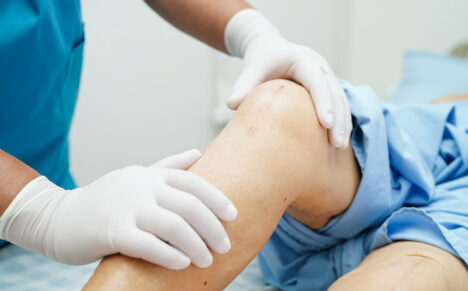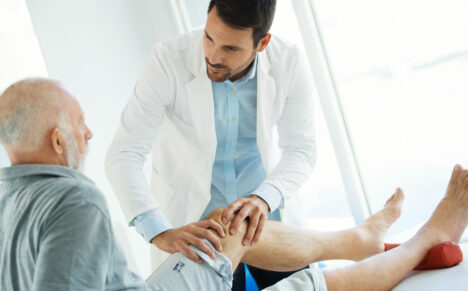The 4 Stages of Hip Osteoarthritis: Symptoms, Preventions, and Treatments
Do you have arthritis? A lot of your friends and family members probably have arthritis, too. The CDC states that osteoarthritis affects over 32.5 million U.S. adults, and physicians report that they diagnose hip osteoarthritis more often than any other joint disease or disorder. Not everyone, however, experiences hip osteoarthritis the same way. You may only feel some pain when you get out of bed in the morning or after sitting for a long time. And you might feel fine once you get going.
Why does everyone with osteoarthritis not experience the same problems? Osteoarthritis is a progressive disease that worsens over time, especially without lifestyle changes. The reason you might experience arthritis of the hip differently than others is that you are likely in a different stage of the disease. Orthopedists categorize hip osteoarthritis into four stages, each with distinct symptoms and treatment options.
So, which stage of hip osteoarthritis are you in? Your orthopedic surgeon is most qualified to identify this for you, but here are some general rules.
What Is Hip Osteoarthritis?
 Osteoarthritis, the most common arthritis form, often affects hips and knees, especially as you age. It is usually caused by joint wear and tear, overuse, repetitive motions, or injury. Weight-bearing joints like knees and hips are particularly vulnerable due to their role in absorbing physical stress.
Osteoarthritis, the most common arthritis form, often affects hips and knees, especially as you age. It is usually caused by joint wear and tear, overuse, repetitive motions, or injury. Weight-bearing joints like knees and hips are particularly vulnerable due to their role in absorbing physical stress.
Our joints are designed to handle this stress with smooth cartilage acting as a shock absorber and synovial fluid providing lubrication. However, over time, these protective tissues can wear down. Our joints can deteriorate, causing cartilage to thin and bone spurs to form, leading to pain and chronic discomfort.
What Are the 4 Stages of Hip Osteoarthritis?
Let’s look at the different stages of hip osteoarthritis to help you understand some of your symptoms and possible treatment options.
Stage 1 (Minor) Hip Osteoarthritis
Symptoms: You may not even know if you have Stage 1 osteoarthritis because many people have no symptoms. If anything, you may have a little pain or stiffness, and there may be small bone spurs in your hip joint.
Prevention: At this point, prevention is the best medicine. Your doctor may recommend glucosamine and chondroitin supplements. It is also advisable to stay active, engaging in regular exercise to strengthen your muscles and stabilize and improve the flexibility of your joints.
Treatment: There may be no need for extensive treatment at this stage, but maintaining a healthy lifestyle and weight is crucial.
Stage 2 (Mild) Hip Osteoarthritis
Symptoms: At this stage, you will likely experience hip pain and stiffness, especially in the morning or after sitting. Initial steps may be difficult, but the pain usually subsides once you start moving. X-rays may show bone spurs, but the space between the hip joint bones is still adequate.
Prevention: To prevent worsening symptoms, it is advised to maintain a regular workout schedule. Strengthening the muscles around your arthritic joints is very important to stabilize them.
Treatment: Your doctor might recommend physical therapy to improve joint function and reduce pain. Over-the-counter pain relievers to decrease inflammation may also be suggested.
Stage 3 (Moderate) Hip Osteoarthritis
Symptoms: If you have Stage 3 hip osteoarthritis, you will likely experience pain and stiffness when you start moving, and pain with activity. Going up and down steps, standing for long periods, and walking can be bothersome. Prolonged activity leads to more swelling and inflammation due to larger bone spurs, eroded cartilage, and narrowing space between the hip bones. You might also hear popping or snapping sounds from your hip.
Prevention: Continue the same preventive measures as in Stages 1 and 2.
Treatment: Continue with your Stage 1 or 2 routines to manage discomfort, but you may now need pain medications. Acetaminophen and NSAIDs can help but consult your doctor first. If you are overweight, losing weight can help reduce hip arthritis pain.
At this stage, you should meet with an orthopedic surgeon specializing in hip pain to ensure you are receiving the best treatment. They might recommend physical therapy to strengthen joints and ease pain, injections of steroids to reduce inflammation, or lubricating fluids to replenish natural joint lubrication.
Stage 4 (Severe) Hip Osteoarthritis
Symptoms: As osteoarthritis progresses, you may reach Stage 4 in one or both hips. At this stage, cartilage is thin and brittle, and synovial fluid is diminished, causing constant pain and stiffness, even when inactive. The pain can be severe, making simple tasks difficult and disrupting sleep.
Prevention: At this stage, preventive measures might be less effective, but maintaining a healthy lifestyle is still important.
Treatment: Hopefully by this stage, you have been seeing an orthopedic surgeon because your quality of life can greatly improve with the help of the right physician. They can review your options with you, which may include surgery to replace some or all of the arthritic hip.
Learn more about the surgical options available and what to expect:
The surgical procedures available today are very successful, with faster and easier recoveries than ever before, and you can be left with a hip free of arthritis and free of pain.
Orthopedic Surgeon in Raleigh
Board-certified and fellowship-trained orthopedic surgeon, EmergeOrtho’s Dr. Brett Gilbert specializes in minimally invasive muscle-sparing hip replacements and a wide range of treatment options for hip arthritis. If you feel that you may be experiencing one of the stages of hip osteoarthritis, you can schedule your appointment or request an appointment with Dr. Gilbert using our appointment request form.




